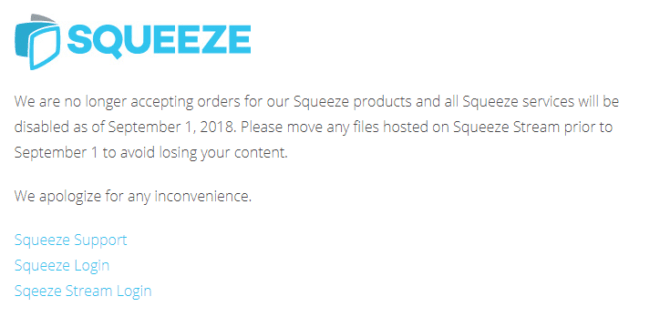Sorenson Squeeze was one of the first encoding tools that many streaming professionals used and now it’s officially end-of-lifed as you can see from the featured image atop this page (from here). It’s not really a surprise; in 2015, I interviewed new Sorenson CEO Marcus Liassides who described how Sorenson would be focusing on building tools to drive the future of broadcast television. Quite a pivot from one of the pioneers of desktop encoding.
Tough to say how successful the company has been in that space. Sorenson appeared to replace Liassides with Pat Nola in May 2018, but the company ranked number 229 on Deloitte’s Fastest Growing Company list of 2017 with revenue growth of 426% in 2017 (Sorenson lists Nola as President/CEO but Liassides’ LinkedIn page shows him still in that role). Whatever the result, it’s hard to criticize Sorenson from moving away from the desktop encoding market, which was squeezed by the ever more capable Adobe Media Encoder on one side, and by the transition from desktop to cloud encoding on the other. The broadcast market clearly had more upside.
Still, sad to see a product I used daily for many years go away, and Sorenson had a great team of developers, marketers, and support personnel. I’m sure they all found great new homes for their talents, but for the product itself, RIP.
 Streaming Learning Center Where Streaming Professionals Learn to Excel
Streaming Learning Center Where Streaming Professionals Learn to Excel










For many, the cloud is no panacea. This is especially true with large files and less than ideal internet connections. For many facilities, even smaller ones, networking computers for cluster encoding is still the better solution yet the solutions in that market are priced well beyond what a smaller facility can afford.
There are still cases where Adobe Media Encoder or Apple Compressor (please don’t forget that as it’s only a $50 stand alone purchase) don’t fit the bill. I’ve heard this from a number of small facilities. Someone should look at that market and find a solution. It may be a bit north of $1000 in price (it’s not going to try to compete with Media Encoder or Compressor) but a solution in the $5000 price range might be viable.
Good to see you here, Craig. Two potential solutions in that space are Capella System’s Cambria Encoder (which I use all the time and really like).
http://www.capellasystems.net/products/cambria-ftc/
And Telestream Vantage.
http://www.telestream.net/vantage/overview.htm
I think that both products start around $6,000 and increase from there. To be fair, they are both much more capable than Squeeze Desktop.
Note that Telestream end of lifed Squeeze competitor Episode a few years ago.
I purchased the final Squeeze upgrade but hardly ever used it–finding Media Encoder a more handy substitute. I am wondering if I should keep the program in order to open old sqz projects. Any thoughts, Jan?
No downside to keeping it, I suppose. Note that I think the project files are XML, so it wouldn’t be that hard to figure out the encoding parameters – just open it in notepad.
🙂